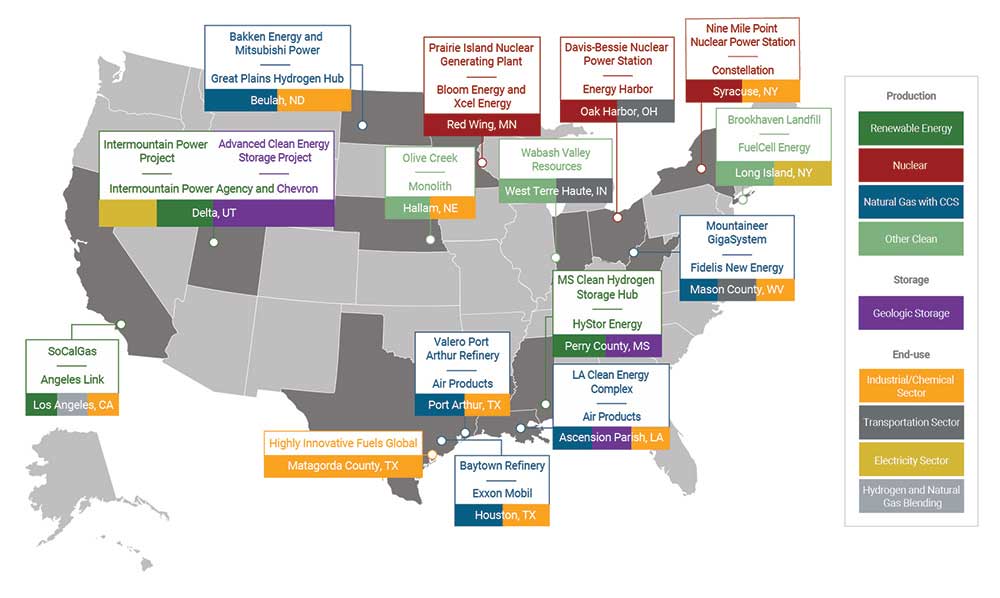Natural gas is usually produced from geologic formations and is primarily composed of a chemical compound called methane (CH4). Natural gas is an energy Swiss Army knife used for electricity generation, transportation fuels and home heating. Natural gas is also used to make a variety of chemicals, such as fertilizers and hydrogen. It can be compressed into liquid natural gas (LNG) and shipped in tankers to countries around the world.
The natural gas industry is one of the most successful examples of American innovation and leadership, resulting in substantial cost reductions. After sky-high energy prices in the early 2000s, the U.S. experienced a natural gas renaissance unlocked by a new technological advancement in natural gas and oil production. The deployment of this technology was due to a combination of federal policies and public/private investments. This technique, called hydraulic fracturing or ”fracking”, allows companies to extract previously inaccessible natural gas and oil deposits. Thanks to fracking, America became the world’s top natural gas producer in 2011 and, as of 2022, the U.S. was responsible for approximately one-quarter of all natural gas production in the world. The second largest producer in the world, Russia, produced almost 40 percent less natural gas than America in 2022. The U.S. also became the world’s largest exporter of LNG in 2022. Current estimates show the United States has enough natural gas to last us through the end of the 21st century. With robust natural gas supplies and low prices, natural gas became the primary fuel for generating electricity in the United States in 2016.
From basic research and development (R&D) through widespread commercialization and export and public/private investments, natural gas and fracking serve as the model for development and deployment of other technologies that reduce emissions along the natural gas value chain. Current policy recommendations are spurring the development and deployment of innovative technologies that reduce emissions from the use of natural gas and generate new fuels and products. Additionally, continuing to export natural gas and improving infrastructure can further deliver economic benefits, improve energy security and continue to reduce emissions. Additional research can develop opportunities outside of these sectors to maximize the economic and environmental benefits of natural gas.
Streamlining Natural Gas Reviews- Streamlining the LNG export approval process is essential to continue to be a leader in exporting natural gas. Applications to export natural gas must be processed in a reasonable amount of time. A single natural gas contract can take years to receive government approval.
Standardize Export Application Reviews- Government reviews of export applications are not standardized. According to the Government Accountability Office, “It is a case-by-case deliberation, where each application is considered separately from the others.” Standardizing the process and setting deadlines on reviews would facilitate U.S. natural gas exports and lower emissions in other countries by displacing higher-emitting fuel sources. In 2019, the DOE finalized a rule to fast-track small-scale natural gas exports. The changes reduce the regulatory burden of qualifying natural gas export contracts. To increase certainty for project developers, these changes could also be formalized by Congress.
The DOE is responsible for authorizing the actual export or import of gas with its powers under the Natural Gas Act (NGA). FERC’s authority under the NGA is the exclusive authority to approve or deny an application for the siting, construction, expansion, or operation of an LNG terminal located onshore or in near-shore waters. An easy way to think about it is that FERC approves the infrastructure and DOE has the authority to approve LNG exports to countries that do not have a free-trade agreement with the US.
Facilitating Natural Gas Free Trade Agreements- is another area that needs reform. Free trade agreements can be made with select countries to reduce barriers to U.S. natural gas exports. As of March 2022, only 18 countries had a natural gas free trade agreement with the United States. More countries should be added to facilitate natural gas exports. Increased demands for LNG exports to energy-thirsty international markets lead to increased production and lower emissions. Between 2022 and 2050, the production of natural gas in the U.S. is projected to increase by 15%, and LNG exports are projected to increase by 152%.
Modernizing Infrastructure- Improving infrastructure is imperative and can be achieved by establishing deadlines for pipeline permit decisions, creating pipeline corridors and reducing natural gas waste. More than 300,000 miles of natural gas pipelines crisscross America, bringing energy to homes and factories. Still, this immense network is proving insufficient in moving the vast U.S. shale gas reserves to where they’re needed. Currently, a single interstate natural gas pipeline permit can take 2 years or more to be approved by FERC. Establishing regular and enforceable deadlines would reduce the regulatory burden and uncertainty on prospective pipeline developers. The federal government can establish pre-permitted corridors to expedite the environmental review process for future pipeline developers. The industry is deploying technologies to reduce incidental methane leakage from equipment, commonly referred to as “fugitive emissions,” such as from pipe connectors and valves. These strategies can be extremely effective climate solutions because methane is a more potent greenhouse gas than carbon dioxide (CO2).

